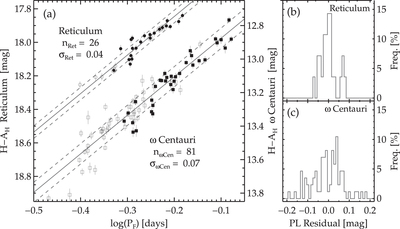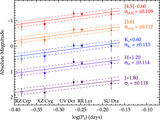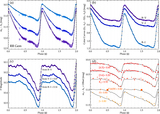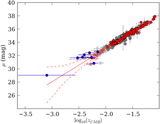Image Details

Caption: Figure 4.
Scatter about the H PL. (a) Near-infrared (H) period–luminosity relations for 26 RR Lyrae variables in the Reticulum cluster with a scatter of only ±0.04 mag (upper) and for the 81 least crowded RR Lyrae variables in ω Centauri, showing a scatter of only ±0.07 mag (lower). In the plot, the open symbols denote RRc type variables, and filled symbols denote RRab type variables. There are four RRab pulsators with the Blashko effect in Reticulum, these are indicated by a larger open circle. Solid lines show the fitted PL relationships based on the slope determined from the Galactic globular cluster, M4 (Braga et al. 2015), and dashed lines show the ± 1σ ranges about the PL. This intercomparison places an upper limit on the contribution of effects that are astrophysical in nature (metallicity, evolutionary state, etc.) to the observed scatter in ω Centauri. (b) Marginal distribution of PL residuals for Reticulum with a scatter of ﹩\sigma =0.04﹩ mag. (c) Marginal distribution of PL residuals for ω Centauri with a scatter of σ = 0.07 mag.
Copyright and Terms & Conditions
© 2016. The American Astronomical Society. All rights reserved.










